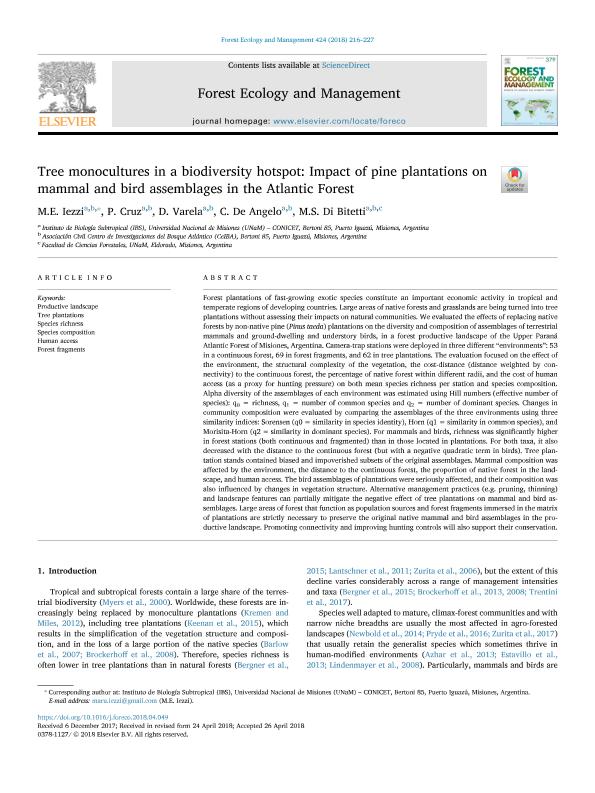Artículo
Tree monocultures in a biodiversity hotspot: Impact of pine plantations on mammal and bird assemblages in the Atlantic Forest
Iezzi, María Eugenia ; Cruz, María Paula
; Cruz, María Paula ; Varela, Diego Varela
; Varela, Diego Varela ; de Angelo, Carlos Daniel
; de Angelo, Carlos Daniel ; Di Bitetti, Mario Santiago
; Di Bitetti, Mario Santiago
 ; Cruz, María Paula
; Cruz, María Paula ; Varela, Diego Varela
; Varela, Diego Varela ; de Angelo, Carlos Daniel
; de Angelo, Carlos Daniel ; Di Bitetti, Mario Santiago
; Di Bitetti, Mario Santiago
Fecha de publicación:
09/2018
Editorial:
Elsevier Science
Revista:
Forest Ecology and Management
ISSN:
0378-1127
Idioma:
Inglés
Tipo de recurso:
Artículo publicado
Clasificación temática:
Resumen
Forest plantations of fast-growing exotic species constitute an important economic activity in tropical and temperate regions of developing countries. Large areas of native forests and grasslands are being turned into tree plantations without assessing their impacts on natural communities. We evaluated the effects of replacing native forests by non-native pine (Pinus taeda) plantations on the diversity and composition of assemblages of terrestrial mammals and ground-dwelling and understory birds, in a forest productive landscape of the Upper Paraná Atlantic Forest of Misiones, Argentina. Camera-trap stations were deployed in three different “environments”: 53 in a continuous forest, 69 in forest fragments, and 62 in tree plantations. The evaluation focused on the effect of the environment, the structural complexity of the vegetation, the cost-distance (distance weighted by connectivity) to the continuous forest, the percentage of native forest within different radii, and the cost of human access (as a proxy for hunting pressure) on both mean species richness per station and species composition. Alpha diversity of the assemblages of each environment was estimated using Hill numbers (effective number of species): q0 = richness, q1 = number of common species and q2 = number of dominant species. Changes in community composition were evaluated by comparing the assemblages of the three environments using three similarity indices: Sorensen (q0 = similarity in species identity), Horn (q1 = similarity in common species), and Morisita-Horn (q2 = similarity in dominant species). For mammals and birds, richness was significantly higher in forest stations (both continuous and fragmented) than in those located in plantations. For both taxa, it also decreased with the distance to the continuous forest (but with a negative quadratic term in birds). Tree plantation stands contained biased and impoverished subsets of the original assemblages. Mammal composition was affected by the environment, the distance to the continuous forest, the proportion of native forest in the landscape, and human access. The bird assemblages of plantations were seriously affected, and their composition was also influenced by changes in vegetation structure. Alternative management practices (e.g. pruning, thinning) and landscape features can partially mitigate the negative effect of tree plantations on mammal and bird assemblages. Large areas of forest that function as population sources and forest fragments immersed in the matrix of plantations are strictly necessary to preserve the original native mammal and bird assemblages in the productive landscape. Promoting connectivity and improving hunting controls will also support their conservation.
Archivos asociados
Licencia
Identificadores
Colecciones
Articulos(CCT - NORDESTE)
Articulos de CTRO.CIENTIFICO TECNOL.CONICET - NORDESTE
Articulos de CTRO.CIENTIFICO TECNOL.CONICET - NORDESTE
Articulos(IBS)
Articulos de INSTITUTO DE BIOLOGIA SUBTROPICAL
Articulos de INSTITUTO DE BIOLOGIA SUBTROPICAL
Citación
Iezzi, María Eugenia; Cruz, María Paula; Varela, Diego Varela; de Angelo, Carlos Daniel; Di Bitetti, Mario Santiago; Tree monocultures in a biodiversity hotspot: Impact of pine plantations on mammal and bird assemblages in the Atlantic Forest; Elsevier Science; Forest Ecology and Management; 424; 9-2018; 216-227
Compartir
Altmétricas



